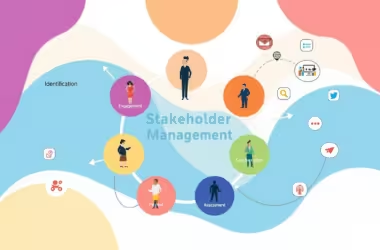Wondering how to shine in Amazon’s tough interview process and get a dream job? In this innovation hub, your fit with Amazon’s 16 Leadership Principles really matters1. These principles guide Amazon’s culture. They are crucial in behavioral interviews. These account for a huge part of the assessment for all roles2. It takes 2-4 weeks and 4-6 interviews to go through the hiring process. So, getting ready is key3.
Let’s explore the Leadership Principles you need to grasp. No matter if you’re aiming to be a Software Development Engineer (SDE) or a Front End Engineer (FEE), showing you understand these principles is vital1. From putting customers first to thinking ahead, knowing these principles not just helps you stand out. It positions you as a leader in Amazon’s vibrant team1.
Understanding Amazon’s Leadership Principles
Amazon’s Leadership Principles, often called Amazon LPs, are key to the company’s culture. They guide decision-making and are essential in hiring. They make sure new hires fit Amazon’s core values.
What Are Amazon’s Lineadship Principles?
In 2002, Amazon started with 10 Leadership Principles. Now, there are 164. They include values like Customer Obsession and Ownership, and push for a focus on innovation and long-term success56. These principles affect how Amazon employees work together, handle problems, and decide on actions across the world4.
Why They Matter for Your Interview
Knowing Amazon’s Leadership Principles is key for interview success. Amazon’s interviews look at your abilities through your past actions4. Interviewers want to see if you fit Amazon by using these principles6. You must share detailed stories that show you live by these principles, using the STAR method6.
This makes sure Amazon hires those who can lead and solve problems. Only candidates who match Amazon’s high standards and can lead effectively are chosen64.
These Leadership Principles mean every hire brings growth and value to their teams6. Amazon’s approach to hiring and leadership ensures a culture of ongoing improvement and high standards54.
1. Customer Obsession: Putting Customers First
At Amazon, putting the customer first is key. The company’s leaders focus on what customers need most. They work from the customer’s view backward. This method involves using customer feedback to stay ahead of the competition78. When interviewing, be ready to discuss how you have gone above and beyond for customers. Talk about dealing with tough customers and using feedback for improvements79.
How to Demonstrate Customer Obsession
For a successful interview, use the STAR method to talk about customer service. This approach helps you explain how you’ve made customers happy. Share stories where you figured out what customers needed and solved problems to make their experience better8.
When giving examples, show how you focus on providing top-notch service and anticipating customer needs79.
Common Pitfalls to Avoid
A big mistake in interviews at Amazon is not thinking about the customer. Make sure your examples show you taking action to meet customer needs. Don’t just deflect or avoid conflicts. Also, don’t do projects just to be popular or beat competitors. This doesn’t show true customer care9.
Instead, highlight how you use customer feedback to improve what you offer78.
2. Ownership: Thinking Long-Term
The Ownership idea at Amazon is all about thinking ahead. It means not just looking for quick wins. Instead, it involves creating lasting value. Staff are urged to think about the company as a whole, not just their own work. This way, they help Amazon succeed in the long run. The company’s Leadership Principles guide this thinking. These are 16 key ideas that also help decide who gets hired6.
When applying for a job, showing Ownership is key. This means spotting problems and fixing them on your own. It’s about doing more than just your assigned tasks; it’s about helping achieve the company’s big goals. Amazon likes people who step up to solve issues, even if it’s not in their job description. Thinking this way leads to lasting solutions and shows Amazon’s focus on the future.
Looking at different stories, we see Amazon folk stepping up. They take on challenges beyond their usual duties. This has really helped with getting projects done10. Ownership isn’t new at Amazon; it’s been part of its culture for over 20 years. Thanks to Jeff Bezos, the company’s founder, there’s a strong sense of taking initiative and looking ahead11. There are tons of examples where team members thought big for the sake of the company’s goals10.
Andrew Jassy, Amazon’s CEO, also believes long-term thinking is key for innovation. With the Ownership principle, this thinking is central. It means employees focus on full solutions, not quick fixes. This approach doesn’t just help with current projects. It sets Amazon on a path for long-term success11.
3. Invent and Simplify: Encouraging Innovation
Amazon’s “Invent and Simplify” principle highlights the need for constant innovation and efficient processes. It encourages staff to question the usual ways, promoting a culture ready for innovative solutions. Success here is seen in those who’ve innovated and streamlined complex processes before.
Amazon looks for candidates with a solid background in innovation. Be ready to share two strong examples for each leadership principle during interviews. This helps interviewers dig deeper into your experience12. Each interviewer focuses on different leadership principles for a comprehensive evaluation13.
One interesting part of this principle is its embrace of automation stories. These should show major business benefits, like time-saving and increased efficiency12. Amazon wants thinkers focused on long-term innovation, not just quick wins13. Show how you’ve creatively solved issues and streamlined operations while being open to new ideas14.
Amazon leaders love new ideas, even from outside their field. This creates a rich ground for innovation14. By showing how you’ve solved problems creatively and improved processes, you prove you’re a good match. It highlights your ability to contribute significantly to Amazon’s innovation culture.
4. Are Right, A Lot: Making Sound Decisions
Making sound decisions is key to aligning with Amazon’s leadership principle, “Are Right, A Lot.” It involves using well-informed strategy, valuing different views, and ensuring decisions are of high quality. These actions show you have good judgment.
How to Show Strong Judgment
To show your strong judgment, get ready to share past experiences. You should have stories about using informed decision-making. It’s good to have two stories for each Amazon leadership principle ready15. For “Are Right, A Lot,” include a conflict resolution story, a tale of learning from mistakes, and a data-driven decision-making example15.
First, describe a situation where you considered various opinions before making a decision. This shows you value diverse insights. Then, share a moment when your decisions resulted in maintaining high-quality outcomes. This highlights your judgment skills.
Jay Shankar’s five-year journey at Amazon Web Services is a perfect example16. She mastered the Amazon Leadership Principles by embracing various perspectives and digging deep into details. Her efforts greatly helped her make informed decisions and succeeded.
Avoiding Common Mistakes
Overconfidence and stubbornness can hurt your chance to show strong judgment. Interviews often include questions about mistakes or failures, especially with the “Are Right, A Lot” principle15. Be honest and aware of your actions when responding to these questions15. Sharing how you fixed your mistakes and learned from them is crucial.
A Big Data Consultant shared a story where a scope creep delayed a project. It cost an extra month and a hundred thousand dollars15. He talked about the mistake, the financial impact, how he fixed it, and how it led to better decision-making later. This story shows learning and growth from past errors.
Focusing on informed decision-making and valuing different perspectives is vital. It’s not just about showing you have strong judgment. It also meets Amazon’s expectation for leaders to make the right decisions often.
5. Learn and Be Curious: Continuous Improvement
Amazon’s leadership principle, “Learn and Be Curious,” urges a never-ending search for knowledge. It highlights improving oneself and one’s skills constantly. This value boosts innovation and adaptability while encouraging a quest for new possibilities17.
It’s a key quality Amazon looks for in people, showing endless curiosity and a drive to get better.
Examples of Curiosity in Action
Amazon checks if people show curiosity and a love for learning. For instance, someone might talk about their first time setting up a Ceph cluster without prior knowledge18. These stories fit with Amazon’s way of working and prove that being adaptable can lead to success.
Telling about times when not changing led to problems can also show why being curious is crucial18.
How to Keep Learning and Growing
The IT world changes fast, so it’s vital to keep learning. Amazon tells its leaders to read up, go to events, earn certificates, and dive into their field17. They ask in interviews how people keep getting inspired, learn from others, and question the usual ways17.
Using strategies like CAR or STAR to answer gives your stories depth and impact19. Sharing personal tales can prove you’re good at taking on new challenges and learning from them.
6. Hire and Develop the Best: Building Great Teams
Amazon works hard to find and grow the best talent. This shows its goal to develop top leaders. Jeff Bezos always knew the value of picking the right people for success20. Amazon’s big goals include “Hire and Develop” and being “Earth’s Best Employer”21. Candidates show they fit by sharing their experiences and plans.
Identifying High Performers
For Amazon, finding top employees means boosting its success. They use a strict interviewing method. It checks if candidates can find great talent that fits Amazon’s aims21. The STAR method helps candidates prove their skills with real stories20. High performers get special support to help them do well and help Amazon improve21.
Mentoring and Coaching
Amazon doesn’t just hire the best; it also helps its workers get even better. Managers give ongoing feedback, career chances, and a learning-friendly setting20. Tools like Career Choice aid in this growth, giving employees ways to move up20. Leaders push for better performance, creating a culture of excellence that matches Amazon’s high goals.
By giving structured mentorship and coaching, Amazon keeps improving its team’s skills and results22. This drive for continuous growth keeps Amazon ahead, with a skilled workforce.
7. Insist on the Highest Standards: Driving Excellence
Amazon places a big focus on high standards within its work culture. Keeping these standards high is crucial for success. It does so by checking the quality of work very closely. Amazon ensures these standards stay high in everything they do by constantly checking on service agreements23.
For Amazon interviews, be ready with two solid examples of how you’ve kept high standards23. This shows you believe in always getting better and maintaining strict work standards.
Setting High Expectations
Raising the bar is key to Amazon’s success. During interviews, expect many questions on how you’ve kept high standards23. This helps prove candidates are dedicated to quality and can keep high standards over time.
Maintaining Quality Over Time
It’s important to keep quality consistent. Interviewers look for candidates who can share experiences of keeping high standards24. Explaining this through the STAR framework makes your examples clear and brief24. Showing you’ve made big improvements, like cutting onboarding time in half, demonstrates your dedication to excellence23.
8. Think Big: Embracing Bold Ideas
Amazon’s “Think Big” principle is about having big visions and making a big impact. It pushes us to set huge goals and reach beyond now. AWS says 90% of what they build is because customers need it. This shows they really focus on what customers want25.
At Amazon, thinking big means dreaming and planning carefully. They started Amazon Prime Now in just 111 days, showing fast action. They keep adding new ideas like “Learn and Be Curious” because they always want to get better and learn more25.
Leaders need to guide their teams towards big dreams. Amazon makes almost 400 billion dollars a year, showing what these big ideas can do. Thinking big means creating and following through with huge plans. It’s about taking risks and trying new things26.
9. Bias for Action: Making Timely Decisions
Amazon’s Bias for Action principle is all about quick and smart decision-making in the business world. It means moving fast and taking sensible risks, instead of getting stuck overthinking things.
Overcoming Analysis Paralysis
One big challenge is avoiding analysis paralysis. This happens when too much thinking prevents quick decisions. Jeff Bezos tells managers to act fast, especially when things are busy, like the holiday rush. He believes in making speedy decisions27.
He also thinks that lots of business choices at Amazon can be changed later. They don’t need long studies28. To show Bias for Action well, prepare several plans for different situations. This helps answer questions in interviews in a smart, quick way29.
Taking Calculated Risks
Taking smart risks is also key to Bias for Action. Research by McKinsey shows that making fast decisions and acting on them can lead to 9-17% more success27. A story about an Amazon Senior Backup Engineer making quick fixes shows how to balance speed and caution29.
When interviewing, share stories of how fast choices led to great outcomes. For example, an Amazon Solutions Architect quickly adding features to a product showcases Bias for Action and Customer Obsession29. Using similar stories can help underline your grasp of this principle and impress in interviews.
10. Frugality: Doing More with Less
Frugality at Amazon is often seen wrongly. It’s not about cutting corners. It’s about being *resourceful* to get great results. By focusing on using every dollar wisely, frugality improves how things operate. It makes *cost-effectiveness* a natural practice.
Amazon’s team members are urged to show frugality. It’s key in roles linked to money, like Finance and Operations30. One example is a Category Marketing Manager. They got a sponsorship deal for a new rewards program on a tight budget30. Another is a DevOps Engineer. They suggested creating an in-house software tool, saving money over pricier options30.
Using frugality means being smart with resources, setting big goals, and being okay with failure31. Amazon teams use their *cleverness* and negotiation skills to do amazing things, even with less31. This promotes innovation and independence, showing big wins come from managing resources well.
Adding frugality into everyday work boosts *cost-effectiveness* and sparks innovation. Thinking out-of-the-box becomes common when you aim to do more with less. This insight comes from the author’s experiences. They saw Amazon’s leadership principles at work in three different countries over thirteen years31.
11. Earn Trust: Building Credidity
At Amazon, building trust is key to being a credible leader and creating a positive team atmosphere. Leaders must always listen well, talk honestly, and show respect to everyone32. It’s crucial for those interviewing at Amazon to show they can be trusted over time.
Teamwork at Amazon depends on trust. A leader must gain and return the trust of their team members32. During interviews, candidates need to talk about winning a client’s trust fast, guiding team members to communicate better, and giving thoughtful feedback to improve relationships32.
Ways to Earn Trust as a Leader
Trust-building at Amazon goes beyond just wise decision-making and keeping promises. It includes respecting others and their ideas, following high moral standards, and owning up to mistakes32. Leaders should also know how to achieve goals by listening, talking, and delegating effectively32. Sharing examples of how you’ve done this in an interview is key.
Leaders must embrace the ‘Day 1 mentality,’ which means focusing on long-term wins rather than short-term gains33. This is about taking charge of more than your own tasks and seeing the bigger picture34. Demonstrating these qualities shows strong leadership and helps build a positive team.
Maintaining Trust Over Time
Keeping trust is just as important as earning it. Amazon leaders are pushed to always improve the quality of products and services33. Being transparent and reliable, keeping your word, and acting with integrity helps keep a team’s trust. This creates a space where workers feel appreciated and listened to, helping to keep their trust and loyalty
The interview process at Amazon focuses on its culture of ongoing improvement and preparing for future roles33. Candidates should have many examples of how they’ve lived each leadership principle. This detailed preparation helps make sure candidates fit well with Amazon’s values and can add positively to the team long-term.
12. Dive Deep: Paying Attention to Detail
The twelfth Amazon Leadership Principle, “Dive Deep,” focuses on deep analysis and detail. Amazon leaders work closely with their projects. They quickly find and solve the main issues35. Their careful research helps make informed decisions and keep standards high.
In 2020, Amazon said it would create 33,000 new jobs in the US36. This growth means leaders need to think analytically, understand their work deeply, and constantly check their facts and figures37. By doing regular checks and questioning data, leaders make sure their teams do great work35.
How to Master the Details
To master details, you need to be diligent and curious. Prepare two examples for each leadership principle that show your deep understanding of your task35. The STAR method (Situation-Action-Result) is great for sharing these stories in interviews36. For example, a Systems Engineer might explain how updating hardware boosted performance by 35%35. A Data Scientist could discuss using machine learning to find spam in political texts35.
Avoiding Surface-Level Thinking
Avoiding surface-Level thinking is about finding the real reasons behind a problem. Amazon leaders are expected to dig deep, understanding all aspects of a challenge35. This deep analysis leads to good solutions and significant improvements37. By doing this, leaders show they are true to the “Dive Deep” principle and can manage complex tasks well.
In summary, the “Dive Deep” leadership principle at Amazon stresses the need for detail-focused, analytical, and skeptical thinking. Embracing these qualities shows you can thrive in Amazon’s focus on excellence and strategic understanding353637.
13. Have Backbone; Disagree and Commit: Constructive Disagreement
The principle “Have Backbone; Disagree and Commit” is key at Amazon. It helps create a culture where it’s good to challenge decisions but still aim for the best results. Leaders show their dedication by questioning decisions in respectful ways. This approach leads to considering many different ideas, making decisions better and stronger3839.
Examples of Constructive Disagreement
Amazon sees constructive disagreement in different situations. Imagine a team meeting where leaders don’t agree on what direction to take a project. It’s vital they share their thoughts openly but kindly. Through real-life stories from Amazon, we see how employees handle disagreements but stay dedicated to their team’s objectives38.
Commitment After Decision-Making
At Amazon, once a decision is made, everyone is expected to fully support it. This happens even if there was disagreement before. What’s important is moving forward together for the decision’s success. This way of balancing disagreement and dedication shows what Amazon’s leadership stands for. It’s about putting team goals first, even if it means setting aside personal beliefs39.
14. Deliver Results: Achieving Your Goals
Delivering results is key at Amazon. It mixes high performance with achieving goals, even when things get tough. Preparing for an Amazon interview? Make sure to have solid examples of how you’ve achieved great results40.
Setting and Meeting Ambitious Goals
Being focused is important when aiming high. Amazon interviewers look for how well you manage projects, especially on tight schedules. They value what you have done more than team achievements41.
Show them your track record of hitting targets. And don’t forget to mention times you went beyond what was expected4041.
Overcoming Obstacles
Talk about challenges and staying on track despite difficulties. Share examples of your success, even in hard conditions41. You might be asked about times you excelled despite having lots to do or limited resources40.
This proves you can handle the pressure at Amazon. Your ability to tackle obstacles could set you apart41.
Understanding Amazon’s Cultural Quirks
Amazon’s business values are shaped by a strong company culture. It’s crucial for new employees to get this and fit right in. A major part of this culture is the 16 Leadership Principles, created by Jeff Bezos4243. These principles steer the company’s ethics and how decisions are made.
They’re not just ideas but are used every day in how the company works and in picking new hires.
The Importance of Amazon’s Culture
Getting Amazon’s business essence and its cultural aspects is key for those wanting to join the team. This culture is known for putting customers first. Decisions start with what customers need43.
How well you match these values is big during job interviews and tests. These assess if you’ll thrive in Amazon’s special setting.
Common Cultural Quirks
Getting used to Amazon’s culture means understanding certain unique habits. Their focus on the customer drives them to come up with smart strategies42. Also, they value constant learning and curiosity. They expect everyone to always be pushing for new ideas and better ways43.
By knowing and accepting these habits, candidates are more ready to join this dynamic and inventive team.
Conclusion
As we wrap up this guide, we want to stress something important. Success at Amazon takes more than learning facts. You need to make their Leadership Principles part of your work life. These 16 rules have helped Amazon grow from a small bookstore into one of the top companies in the U.S4445.
To ace your interview, show how you live by these principles every day. Being in tune with Amazon’s values is key. It’s not just for the interview. It shows you’re deeply invested in putting customers first, always learning, and thinking creatively45.
Getting a deep understanding of Amazon’s Leadership Principles shows your dedication to their values. These values, like putting the customer first or being ready to act quickly, guide you to make smart choices and do great things. As you get ready for your interview, use these principles to highlight how well you fit with Amazon’s innovative culture45.
Source Links
- Mastering the Amazon Interview: A Comprehensive Guide to Amazon’s 16 Leadership Principles
- Amazon Interview Questions: The Ultimate Preparation Guide (With Example Stories)
- Acing The Amazon Behavioral Interview: The Ultimate LinkedIn Guide
- Apply the 18 Amazon Leadership Principles Confidently – Hustle Badger
- Amazon 16 Leadership Principles Guide by JobTestPrep
- An interviewer dives deep on Amazon’s 16 Leadership Principles
- How to Answer Amazon Leadership Principle “Customer Obsession” Interview Questions
- Top Answers for Amazon Leadership Principle: Customer Obsession
- Working like an Amazonian: Leadership Principles Explained — 1. Customer Obsession
- Answers for the top 5 Amazon “Ownership” leadership principle interview questions — Interview Genie
- Amazon Leadership Principles
- How to answer interview questions about the Amazon leadership principle “Invent and Simplify” — Interview Genie
- The Amazon Leadership Principles – A Complete Interview Guide
- Does Amazon’s Invent and Simplify Leadership Principle Apply to Your Career? I say YES! But prepare to be misunderstood.
- How to answer interview questions about the Amazon leadership principle “Are Right, A Lot” — Interview Genie
- How Amazon’s Leadership Principles drive career growth and innovation – Jay Shankar – Life at AWS
- How to answer interview questions about the Amazon leadership principle “Learn and be curious” — Interview Genie
- Working like an Amazonian: Leadership Principles Explained — 5. Learn and Be Curious
- Acing “Learn and Be Curious” Amazon Interview Questions
- Answering “Hire and develop the best” Amazon interview question
- How to answer interview questions about the Amazon leadership principle “Hire and develop” — Interview Genie
- Amazon Leadership Principles
- How to answer interview questions about Amazon leadership principle “Insist on the Highest Standards” — Interview Genie
- Amazon interview preparation: “Insist on the highest standards”
- Leading and Innovating with Leadership Principles | AWS Executive Insights
- 14 Amazon Leadership Principles and Why They Matter
- Bias for Action: How to Ace this Amazon Leadership Principle
- BIAS FOR ACTION
- How to answer interview questions about Amazon leadership principle “Bias for Action” — Interview Genie
- How to answer interview questions about the Amazon leadership principle “Frugality” — Interview Genie
- How to Use Amazon’s Leadership Principle Frugality to Accomplish More With Less
- How to answer interview questions about the Amazon leadership principle“Earn Trust” — Interview Genie
- Top Amazon Behavioral Interview Questions and Answers in 2024 – Exponent
- Amazon Job Interview: Leadership Principles — Tannia Suárez
- How to answer interview questions about Amazon leadership principle “Dive Deep” — Interview Genie
- Dive Deep Amazon Interview Questions
- A Guide to the Deep Dive Leadership Principle
- How to answer Amazon “Have Backbone; Disagree and Commit” interview questions
- Amazon Leadership Principles: A Comprehensive Guide – North Shore Tribe
- How to answer interview questions about Amazon leadership principle “Deliver Results” — Interview Genie
- Deliver Results – Amazon Leadership Principle – Amazon Interview Preparation
- Anonymous mock interviews with engineers from FAANG and more
- Amazon Leadership Principles: The Comprehensive Guide for Job Interview and Assessment Test Success!
- A Deep Look Into The 14 Fascinating Amazon Leadership Principles
- The 16 Amazon Leadership Principles






